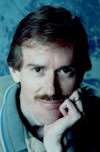 Randy Ingermanson has published six novels and received about a dozen awards for his writing. He holds a Ph.D. in theoretical physics from UC Berkeley and is the entire software department for Vala Sciences, a San Diego biotechnology company. Randy is the inventor of the "Snowflake Method," used by novelists around the world to design their novels. He the publisher of the Advanced Fiction Writing E-zine, the world's largest electronic magazine on writing fiction. More than 1000 novelists read his daily blog, the Advanced Fiction Writing Blog. Randy's goal is to become Supreme Dictator For Life, and he may have already succeeded. Visit his site at www.SupremeDictatorForLife.com. |
The Manly Guy and Christian Fiction by Randy Rooneyaka Randy Ingermanson |
I walked past a long row of pink and white candles exuding many scents. None of them smelled like Sam...At some point in his career, every male Christian novelist has seriously considered changing his name to Helen. Why? Because the Christian fiction industry is pink. Xtremely pink. I did a quick bit of research just now and counted the winners of all Christy Awards to the present. Forty-three were women, twenty-nine were men. That’s a 20 percent gender gap, and it is (as the math geeks will tell you) statistically significant. I also scanned a list of 205 multi-published Christian novelists. One hundred fifty-two were women and fifty-three were men. That’s 74 percent pink, 26 percent blue. It’s enough to make even the manliest guy weep. In search of an explanation for the pinking of Christian fiction, I asked my marketing analyst, Sam. Sam is the manliest guy I know. He weighs 280 pounds, has five o’clock shadow by 9 AM, and never changes his socks. Sam is our plumber, and while I interviewed him, he snaked the bathtub in the kids’ bathroom. “Hey, Sam, how come there are so few male Christian novelists?” Sam pulled a hairball the size of a cat out of the drain and examined it critically for a few minutes. “Novels?” he growled. “Is that like stories or something?” “Yes, fiction.” I held out a Hefty bag for the hairball. Sam dropped it in, then picked his teeth with a blackened thumbnail. “Real men don’t read fiction. They watch movies with helicopters.” “Helicopters?” “Yeah, exploding helicopters. Lots of exploding helicopters. The more the better.” Sam scribbled out a bill. “That’s a hundred dollars for the visit, seventy-five dollars for the hairball, and three hundred dollars for the gender-differentiated market analysis.” While it’s always great to get an expert gender-differentiated market analysis, I thought it would be a good idea to get the view from the trenches. I drove to a large Christian book store, went inside, and asked the clerk where the fiction section was. She gave me a Luna Lovegood smile. “Just down the gift aisle, past the candles, and before you get to the angel art.” I walked past a long row of pink and white candles exuding many scents. None of them smelled like Sam. When I reached a solid wall displaying pictures of smiling cherubs, I realized I’d overshot and backtracked to the fiction section. A fifty-something woman stood reading the back cover of a book. A foot-high stack of novels lay at her feet. I introduced myself as a journalist on a fact-finding mission and asked if I could interview her. She readily agreed. “How many Christian novels do you read every month?” She thought for a minute. “About fifteen.” “And what sorts of novels do you like?” She pulled out three with pink covers from her stack. “Well, of course, I like romance best, but there aren’t enough of them.” “Anything besides romance?” She picked up half a dozen with cover art showing women in gingham dresses wearing bonnets and standing in fields. “I also like historical novels.” “That would be . . . prairie romances, right?” She gave me an odd look. “That’s what I said, historical novels.” A hard knot began to form in my stomach. “Anything else?” She grabbed the last two from her stack. “Well, I like contemporary fiction, too.” I looked at the covers. A pink women’s fiction and . . . a maroon women’s fiction. Thanks to my years of mathematical training, I was beginning to see a pattern. “What other kinds of fiction do you like?” Her eyes narrowed to gray slits. “What other kind is there?” I shrugged. “Maybe something with . . . exploding helicopters?” Her mouth flew open in horror. “What are you, some kind of weirdo? Out! Out!” She swung her purse at me, leaving a Prada logo dent on my face. |
I ran for it, knocking over a stand of Christian jewelry, two displays of Christian candles, and a pink-shrouded table of Christian perfume on the way out the door. Safely home, I dialed an agent friend of mine. When she picked up the phone, I said, “What’s the deal with Christian fiction? Why are there so few male novelists?” “Au contraire,” she said calmly. “There are plenty of men writing Christian fiction. Ted Dekker, Jerry Jenkins, and . . . Ted Dekker.” I waited. “Okay, there are more women writers,” she said. “But more women than men read fiction.” “So I’ve heard.” “And women tend to read romance.” I touched the triangular welt on my face. “I’ve, um, heard that, too.” “And of course there’s the Kindergarten Effect.” I wondered what sort of medication she was on. “The Kindergarten Effect?” She sighed deeply. “Let’s say you’re a mother and you’ve just put your youngest child in kindergarten. You’d like to go back to work, but you don’t want to work full time, and you’ve been out of the work force for ten years. How much are you going to earn?” I did a quick calculation: minimum wage, part-time. “Not very much. Maybe ten K.” “Could you live on that?” I laughed. “Not hardly. Have you seen what gas costs these days?” “So you could go work for Bossbert for diddly, or you could stay at home and write that novel you always dreamed about. You’ve got several hours every day to write. In a year or two, if you’ve got the talent and find your niche, you might sell a book.” “A year or two?” I couldn’t hide my disbelief. “It took me eleven years to sell my first novel.” “Working a day job and writing how many hours a day?” “One, maybe two. Okay, I see your point.” “So you sell your first novel for five K, but it’s a three-book deal, so it’s really fifteen K spread out over a year and a half,” she said. “All of a sudden, you’re earning as much as you could have from Bossbert—” “Not very much,” I pointed out. “Not for a man who’s ten years into a career,” she said frostily. “But about what a woman could earn part-time at minimum wage. And after a three-book deal, she’s now got the skills to write two, three, four books a year. Those might be earning ten K apiece.” “Four books a year?” I said. “That’d kill me, trying to work a day job and writing four books a year. But four books a year couldn’t possibly replace my day job.” “Oops, I’ve got another call incoming,” she said, speaking faster now. “Listen, life’s not fair, but if you want to level the playing field . . .” I leaned forward, sure now that I was going to hear the secret to success. “Yes?” “Learn to like pink, read some romances, and get yourself a husband.” Click. The line went dead. I sat there for a long time, thinking. Then I called my attorney to ask how much it would cost to change my name. To Ted. |









